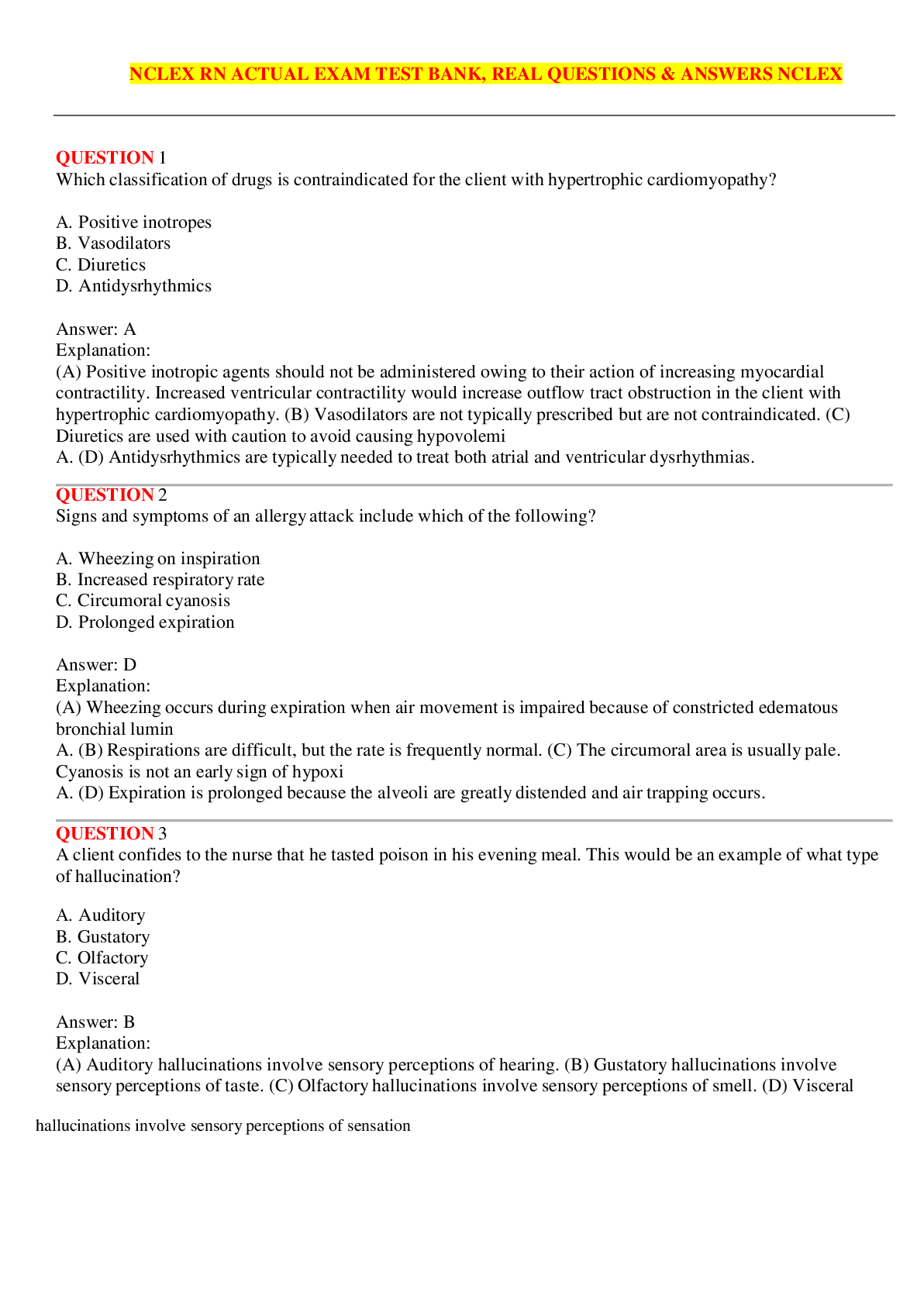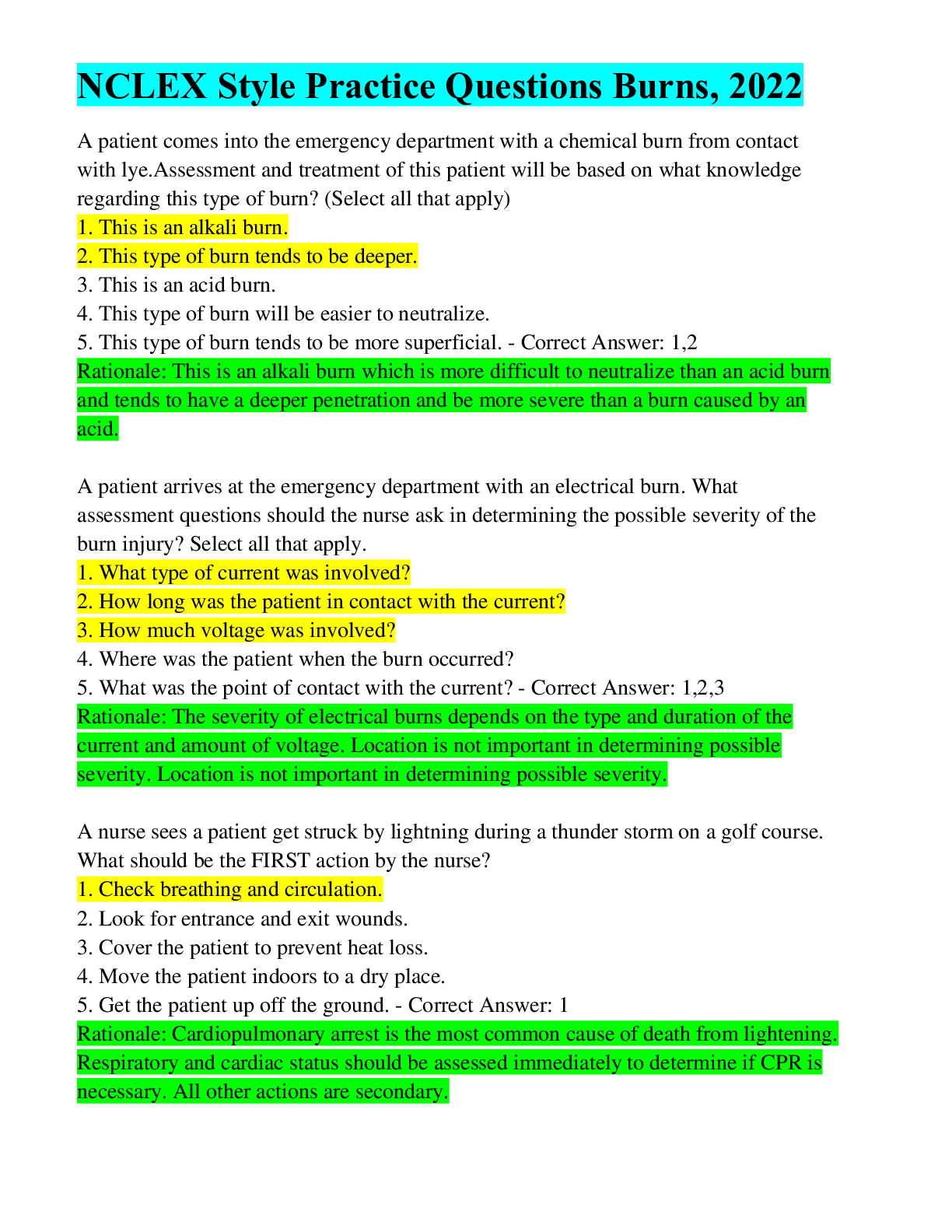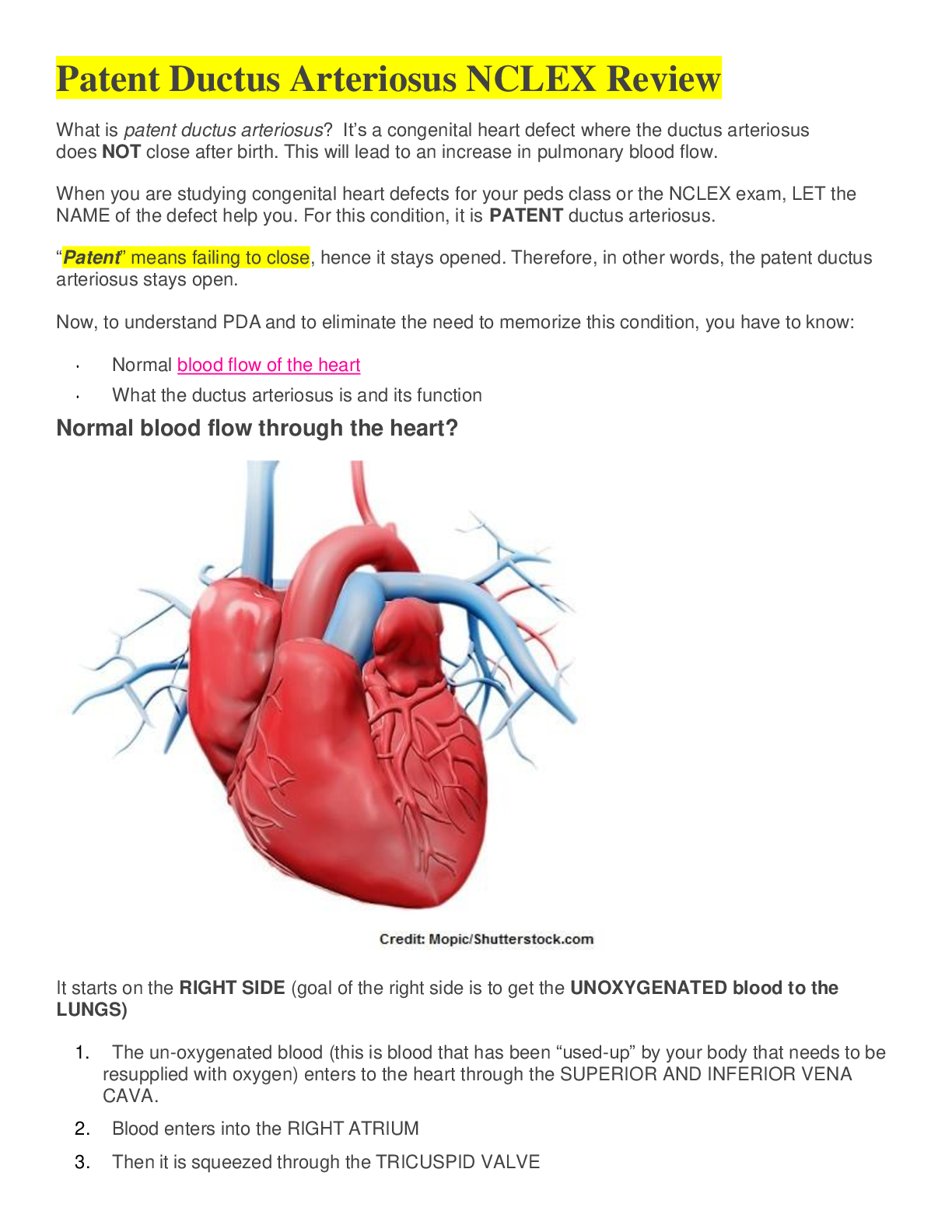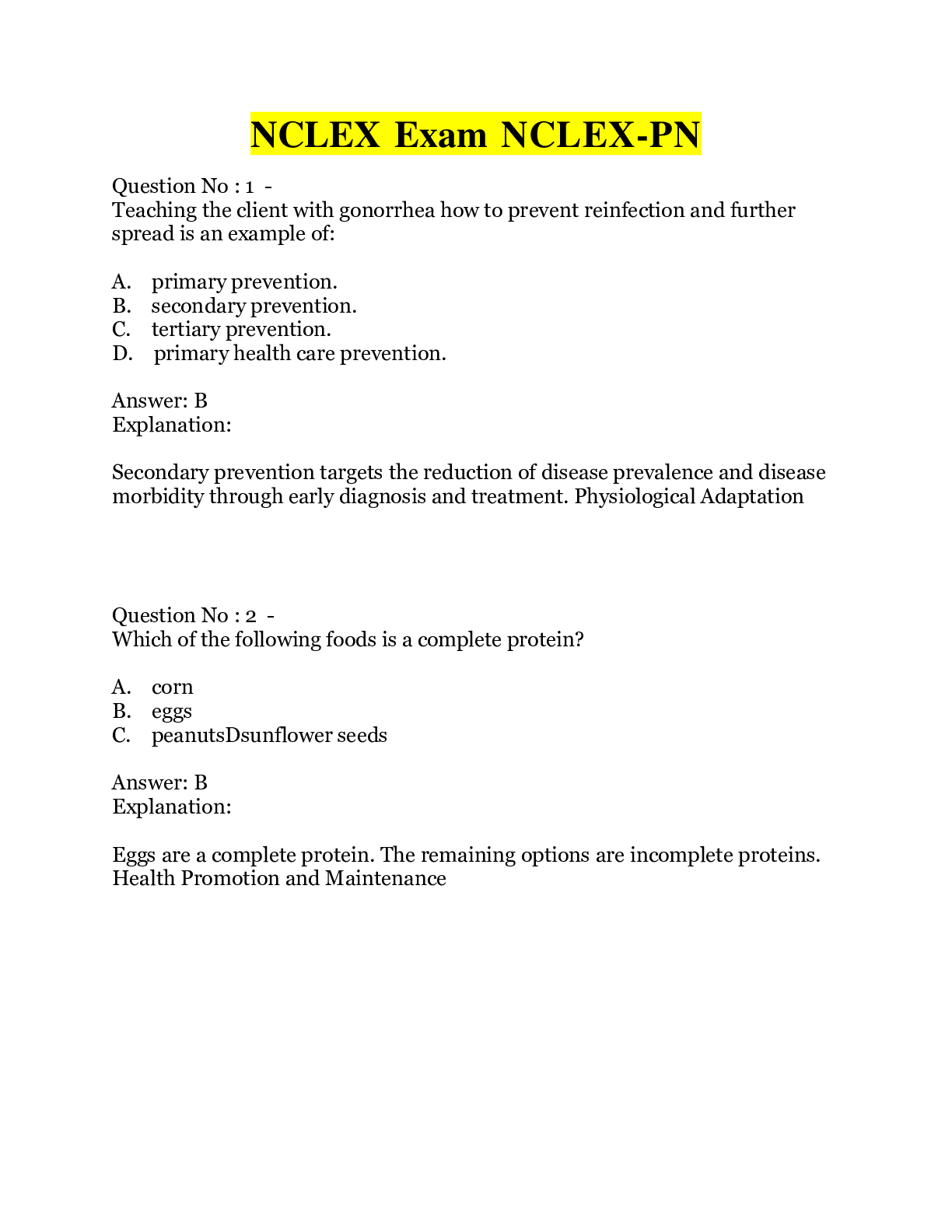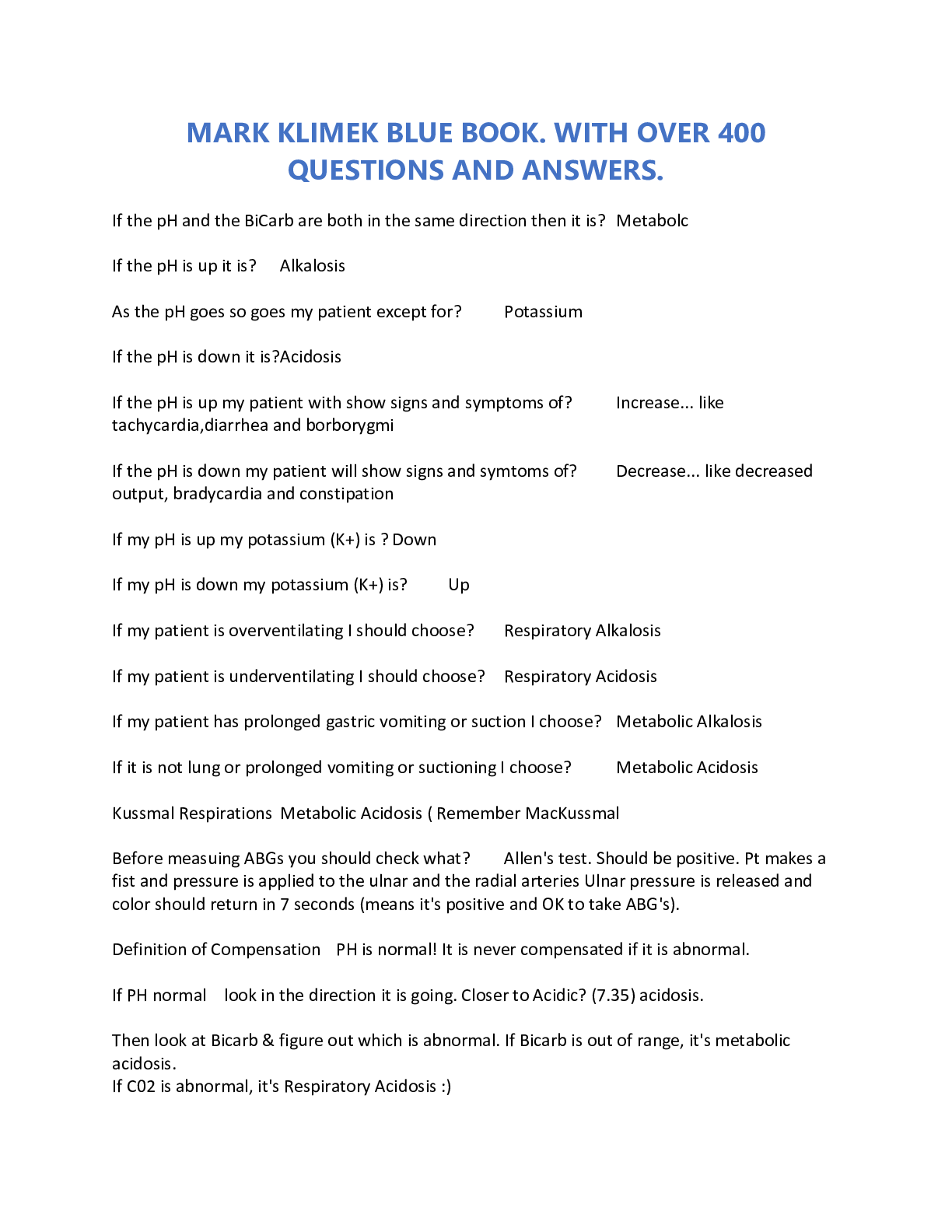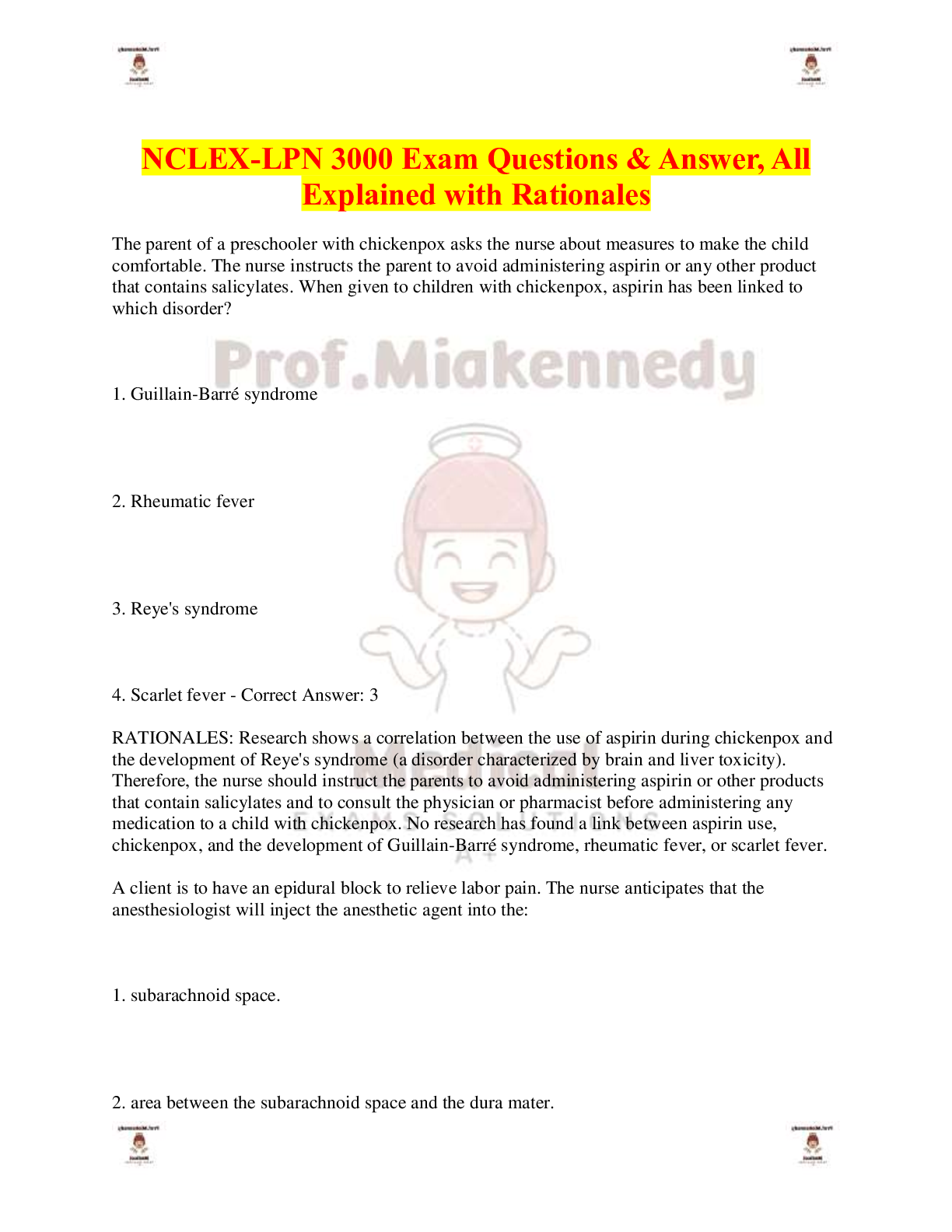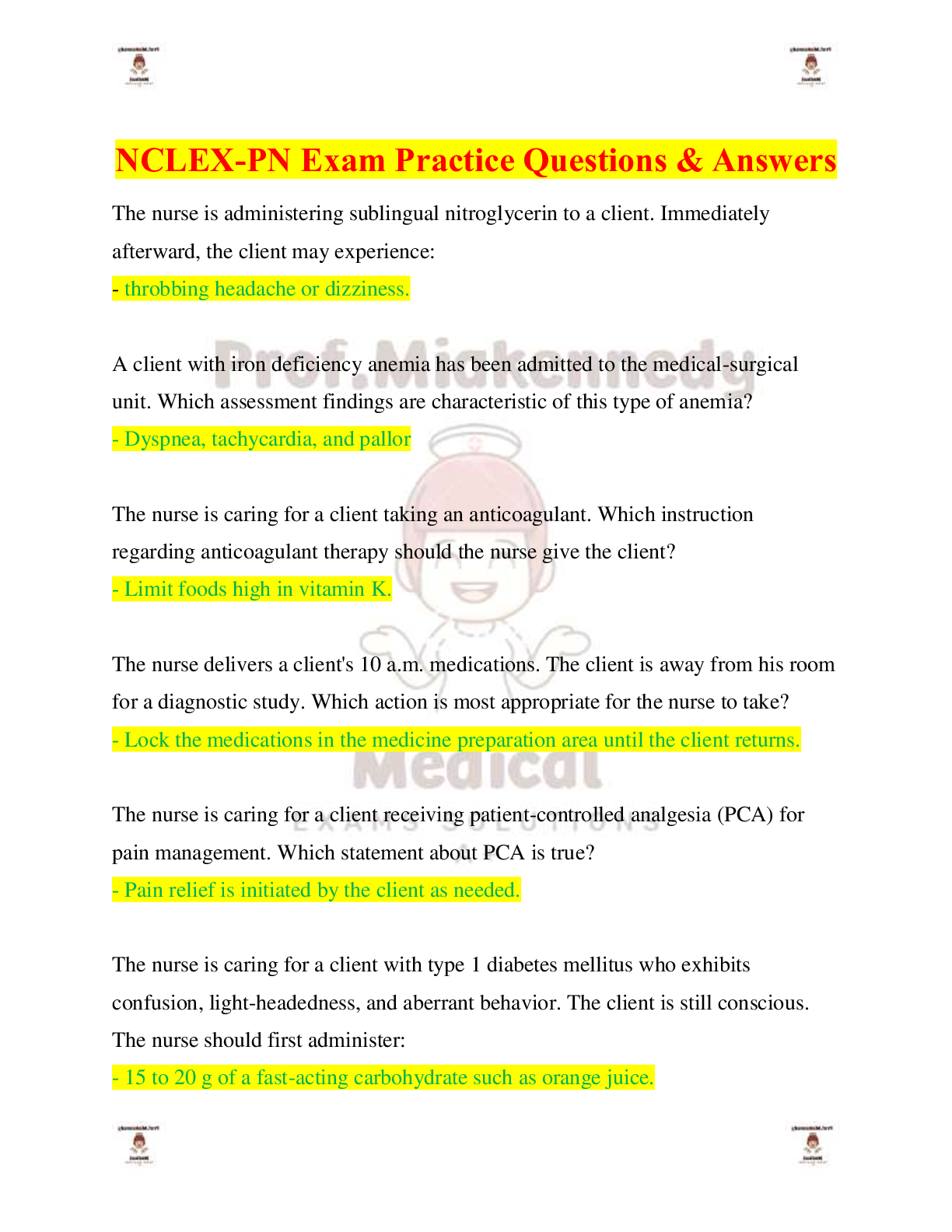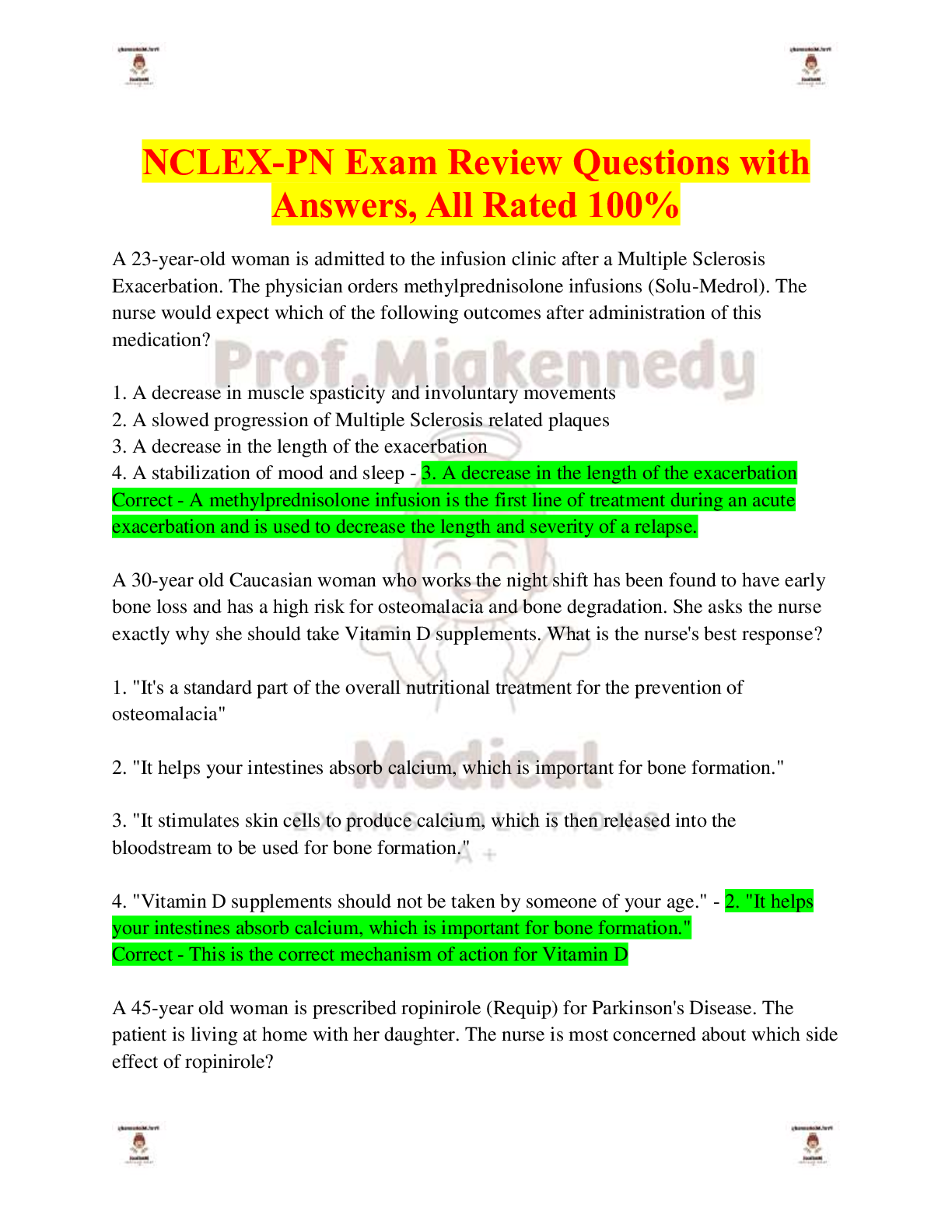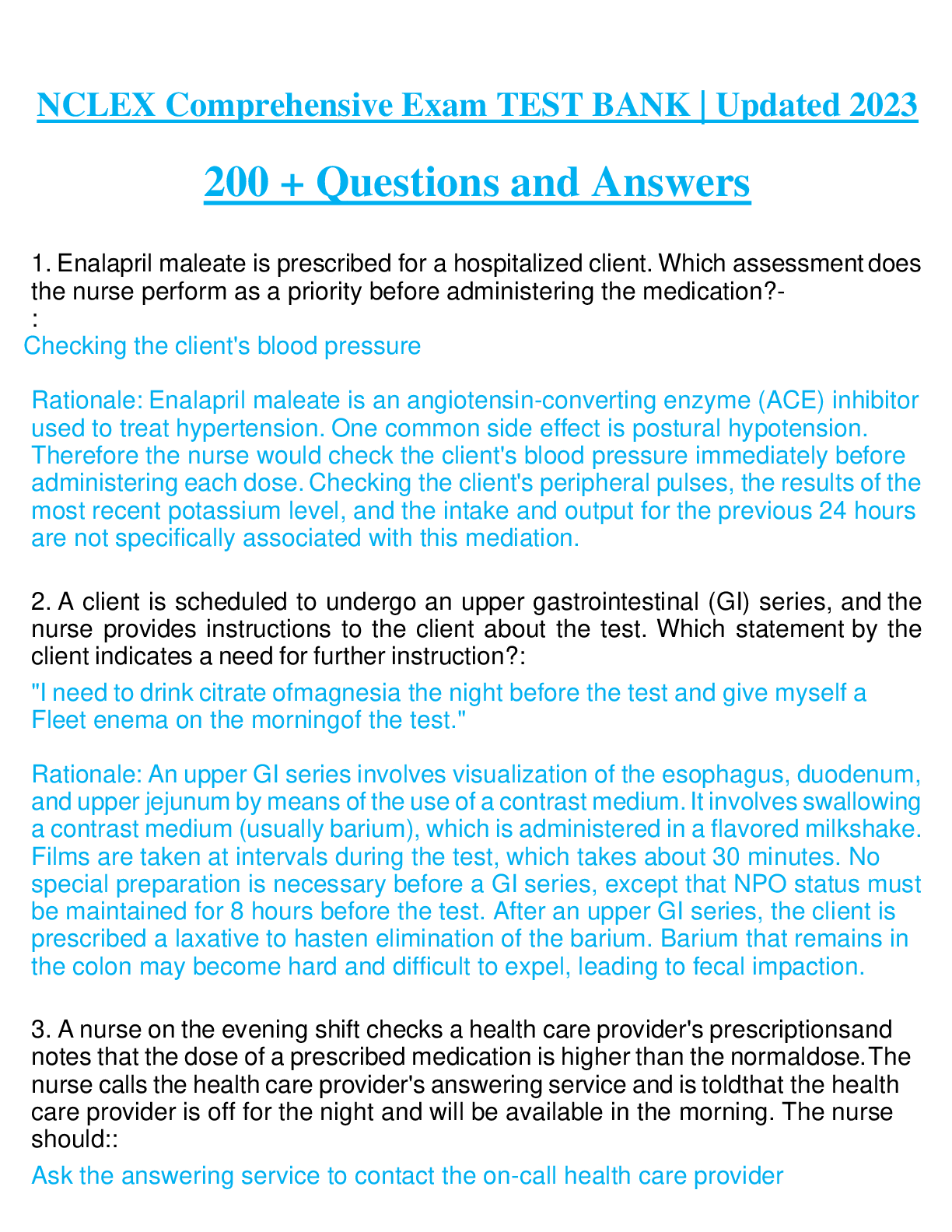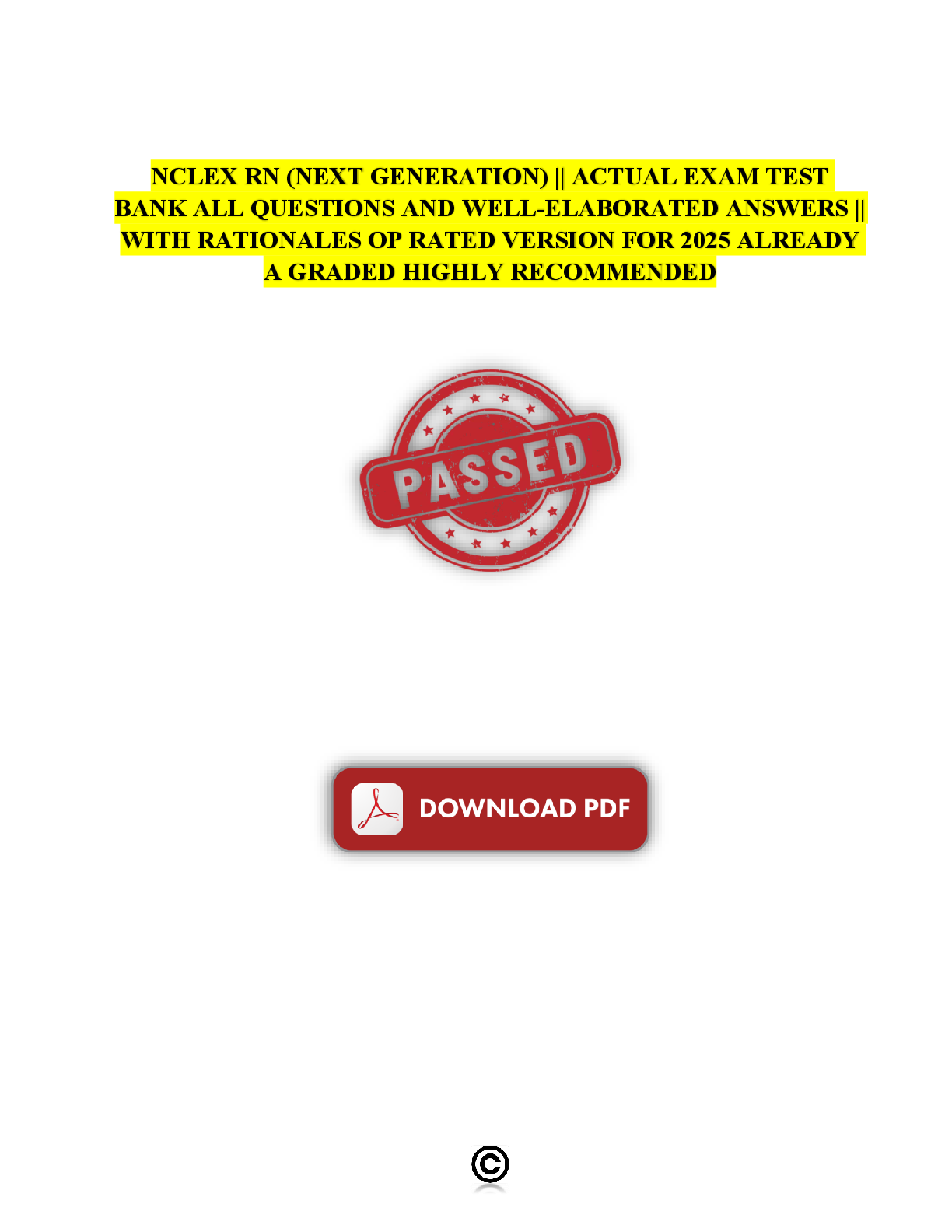*NURSING > NCLEX > LPN NCLEX Exam TEST BANK MULTIPLE CHOICE Questions & Explained Answers, Rated A+ (All)
LPN NCLEX Exam TEST BANK MULTIPLE CHOICE Questions & Explained Answers, Rated A+
Document Content and Description Below
LPN NCLEX Exam TEST BANK MULTIPLE CHOICE Questions & Explained Answers, Rated A+,The nurse is preparing a client for a scheduled colonoscopy. Which prescription should the nurse anticipate from the pr... imary healthcare provider (PHCP) while the client is preparing for this procedure? A. docusate B. loperamide C. polyethylene glycol 3350 D. famotidine-polyethylene glycol 3350 Polyethylene glycol 3350 is an osmotic laxative commonly used before a colonoscopy. This powder is typically dissolved in a sports drink and can be consumed by the client. Efficacy is usually within one hour. Fluid and electrolyte disturbance is unlikely as the powdered solution contains electrolytes.When administering this medication, it should be dissolved in water or Gatorade and may chill in the refrigerator to increase palatability. 3 multiple choice options A patient with a crush injury to her left arm calls the nurse's station and requests pain medication. An hour after administration, the patient is still complaining of intense pain. What is the next nursing action? A. Ask the patient to describe the pain in quality and intensity. B. Offer the patient a distraction, such as a book or television. C. Tell the patient she can have more medication in three hours. D. Tell the patient crush injury victims should expect intense pain.-Ask the patient to describe the pain in quality and intensity. A crush wound is a wound caused by a force that leads to compression or disruption of tissues. It is often associated with fractures. Usually, there is minimal to no break in the skin. While other external symptoms, such as bruising or edema, may be visible, nurses should also rely on subjective symptoms reported by the patient. Choice A is correct. Unrelieved pain is an indication of a complication. Patients who experience a crush injury are at risk for developing compartment syndrome. Therefore, asking the patient to be specific about the quality and intensity of pain is vital in re-evaluating the patient's status. 3 multiple choice options Which of the following situations is an example of negligence? A. The UAP (Unlicensed Assistive Personnel) fills a water basin with warm water while the patient with depression combs her hair. B. A nurse transcribes a new medication order: Questran powder 2 oz bid with wet food or one full glass of water. C. The nurse checks the distal pulses of a patient's legs two hours after they have returned from a cardiac catheterization. D. The nurse observes a UAP enter the room of a patient on contact [4%] precautions wearing gloves and a gown.-C. The nurse checks the distal pulses of a patient's legs two hours after they have returned from a cardiac catheterization. The nurse should have checked the patient's distal pulse immediately after the cardiac catheterization. 3 multiple choice options The nurse is caring for the following assigned clients. Which client should the nurse follow up with first? A. The patient going for an echocardiogram and is allergic to contrast dye. B. The patient refusing to eat their meal following an injection of glargine insulin. C. The patient scheduled for discharge in three hours and needs transportation. D. The patient requesting diphenhydramine after starting an intravenous antibiotic.-D. The patient requesting diphenhydramine after starting an intravenous antibiotic. A client requesting diphenhydramine following the initiation of an antibiotic requires immediate follow-up because the client could be experiencing an allergic reaction ranging from mild to severe. Thus, the nurse should quickly assess the client. 3 multiple choice options Which of the following statements should the nurse use to best describe a very low-calorie diet? A. "This is a long-term treatment measure that assists obese people [30%] who can't lose weight." B. "A VLCD contains very little protein." C. "This diet can be used only when there is close medical supervision." D. "This diet consists of solid food that is pureed to facilitate digestion and absorption."-C. "This diet can be used only when there is close medical supervision." Very Low-Calorie Diets (VLCD) are used in the clinical treatment of obesity under close medical supervision. The diet is low in calories, high in quality proteins, and has a minimum of carbohydrates to spare protein and prevent ketosis. Very low-calorie diets, generally providing fewer than 800 kcal per day, became widely available for outpatient use in treating adult obesity in the 1980s. These diets, sometimes called protein-sparing modified fasts, were associated with significant medical risks (electrolyte abnormalities, arrhythmias, and sudden death). They became widely marketed as part of many commercial weight loss programs. Despite their overall success in supporting rapid weight loss, most patients experienced subsequent weight regain once the very low-calorie diet was discontinued. These extremely hypocaloric diets have been used on a limited basis in the pediatric population, generally in an inpatient setting, with close medical supervision. Given the deficient daily caloric intake associated with the VLCD, this diet requires almost a full liquid approach. Patients are often on 3-5 shakes daily, with multivitamin and mineral supplementation. Side effects include fatigue, hair loss, dizziness, constipation, and risk for cholelithiasis secondary to rapid weight loss. The VLCD usually results in >20% weight loss within the first 3-4 months. Although rapid weight loss is seen, it is not regularly well maintained, with many patients gaining up to 50% of that weight back within the subsequent 12 months; and gaining all of it back in less than five years. LCDs are not as extreme, and with almost twice as many calories allowed (1200-1500 kcal/day), the weight loss is modest. 3 multiple choice options How should the nurse assess for the presence of thrombophlebitis in a patient who reports having pain in the left lower leg? A. By palpating the skin over the tibia and fibula. B. By documenting daily calf circumference measurements. C. By recording vital signs obtained four times a day. D. By noting difficulty with ambulation.-B. By documenting daily calf circumference measurements. Inflammation from thrombophlebitis increases the size of the affected extremity and can be assessed regularly by measuring calf circumference. Thrombophlebitis is an inflammation of a vein associated with thrombus formation. Thrombophlebitis from venous stasis is most commonly seen in the legs of postoperative patients. Manifestations of thrombophlebitis are pain and cramping in the calf or thigh of the involved extremity, redness and swelling in the affected area, elevated temperature, and an increase in the involved extremity's diameter. Each shift, nurses should assess the legs for swelling and tenderness, measure bilateral calf or thigh circumference, and determine if they experience any chest pain or dyspnea. The patient should be instructed not to massage the legs. 3 multiple choice options The nurse is removing a nasogastric tube (NGT). The nurse should take which action? A. Deflate the balloon B. Irrigate the tube with 200 mL of water C. Instruct the client to take a deep breath and hold it. D. Assess the gag reflex-C. Instruct the client to take a deep breath and hold it. Prior to removing the NGT, it would be appropriate for the nurse to tell the client to take a deep breath and hold it as the tube is removed. The nurse should then pinch the tube and remove the tube quickly and steadily over 3-6 seconds while the client holds their breath or during exhalation. 3 multiple choice options A patient is scheduled for an IV pyelogram. He asks the nurse what he needs to do to prepare for the test. Which of the following is the correct response? A. "You need to have a full bladder for the test to be successful." B. "You need to alert the technician if you feel any burning after the dye is injected." C. "You will receive a bowel preparation before the test can be performed." D. "You must lie on your back for four hours after the test is performed."-C. "You will receive a bowel preparation before the test can be performed." Bowel prep is necessary to make sure the x-rays are clear and that urinary structures are not obstructed by bowel contents. An IV pyelogram is an x-ray that is used to view the urinary structures. 3 multiple choice options The nurse is assisting in the placement of an indwelling foley catheter in a male patient. She knows to inflate the balloon on the catheter at which of the following points in the procedure? A. Upon meeting resistance B. As soon as urine is observed in the tubing C. After advancing to the point of bifurcation D. After fully advancing the length of the catheter-C. After advancing to the point of bifurcation The nurse should inflate the balloon on the catheter once she reaches the point of bifurcation. This is achieved by slowly advancing the catheter, observing the tubing for urine to appear, and then continuing to advance to the point of bifurcation after urine is observed. This will ensure the balloon is in the bladder before the nurse inflates it. 3 multiple choice options The licensed practical/vocational (LPN/VN) assists a registered nurse (RN) in planning a staff educational conference about indwelling urinary catheters. Which of the following information should be included? A. Sterile gloves should be used to perform urinary catheter care. B. Urinary specimens may be collected from a catheter bag. C. You may irrigate a catheter with warm water for poor outflow. D. Daily use of soap and water should be used around the urinary-D. Daily use of soap and water should be used around the urinary Daily cleaning of the urinary meatus with soap and water is recommended for catheter care. Sterile gloves do not need to be used for this process as it is a clean procedure. Soap and water is an acceptable practice for daily catheter care as alcohol, CHG, and other antiseptics may be highly irritating to the urinary meatus. 3 multiple choice options [Show More]
Last updated: 1 week ago
Preview 1 out of 272 pages
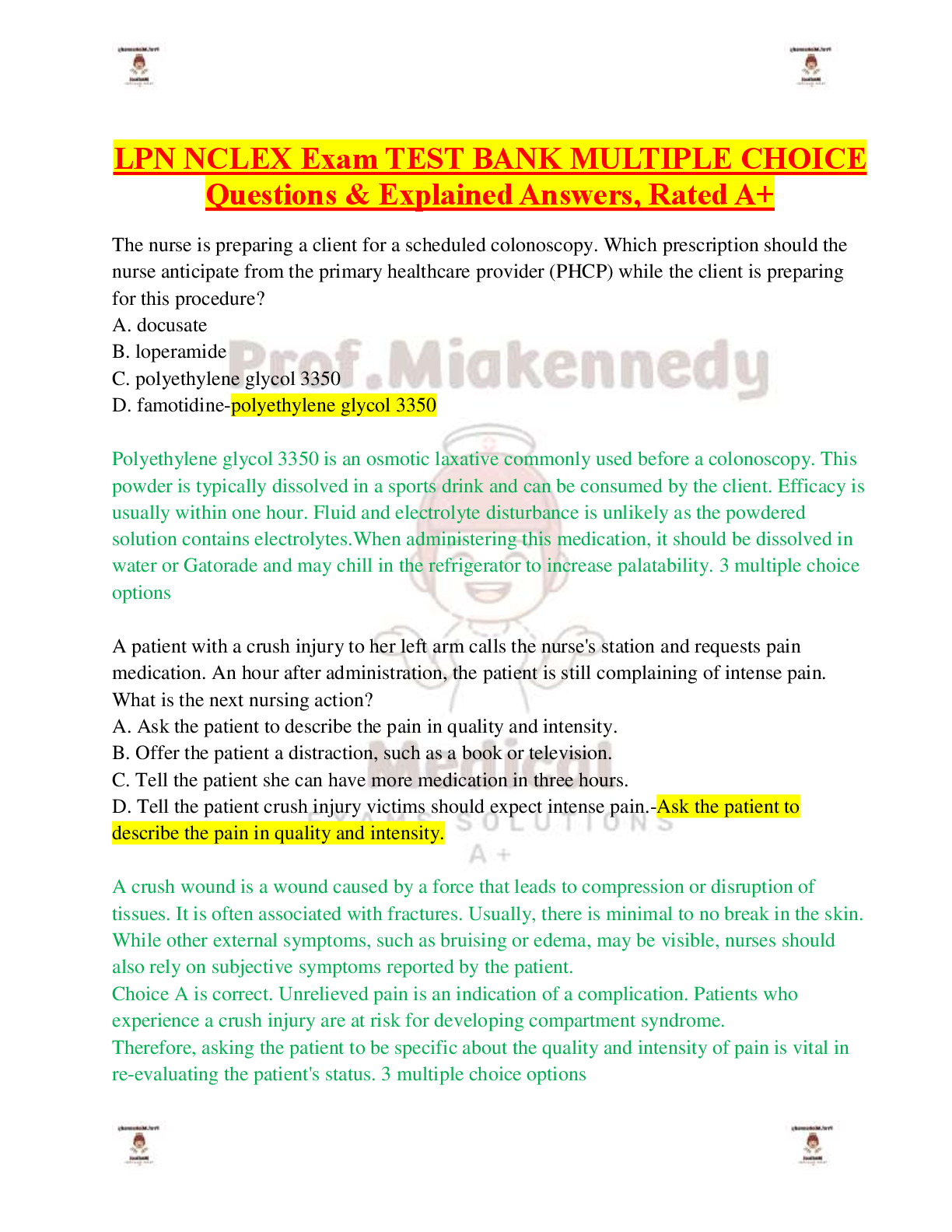
Buy this document to get the full access instantly
Instant Download Access after purchase
Buy NowInstant download
We Accept:

Also available in bundle (1)
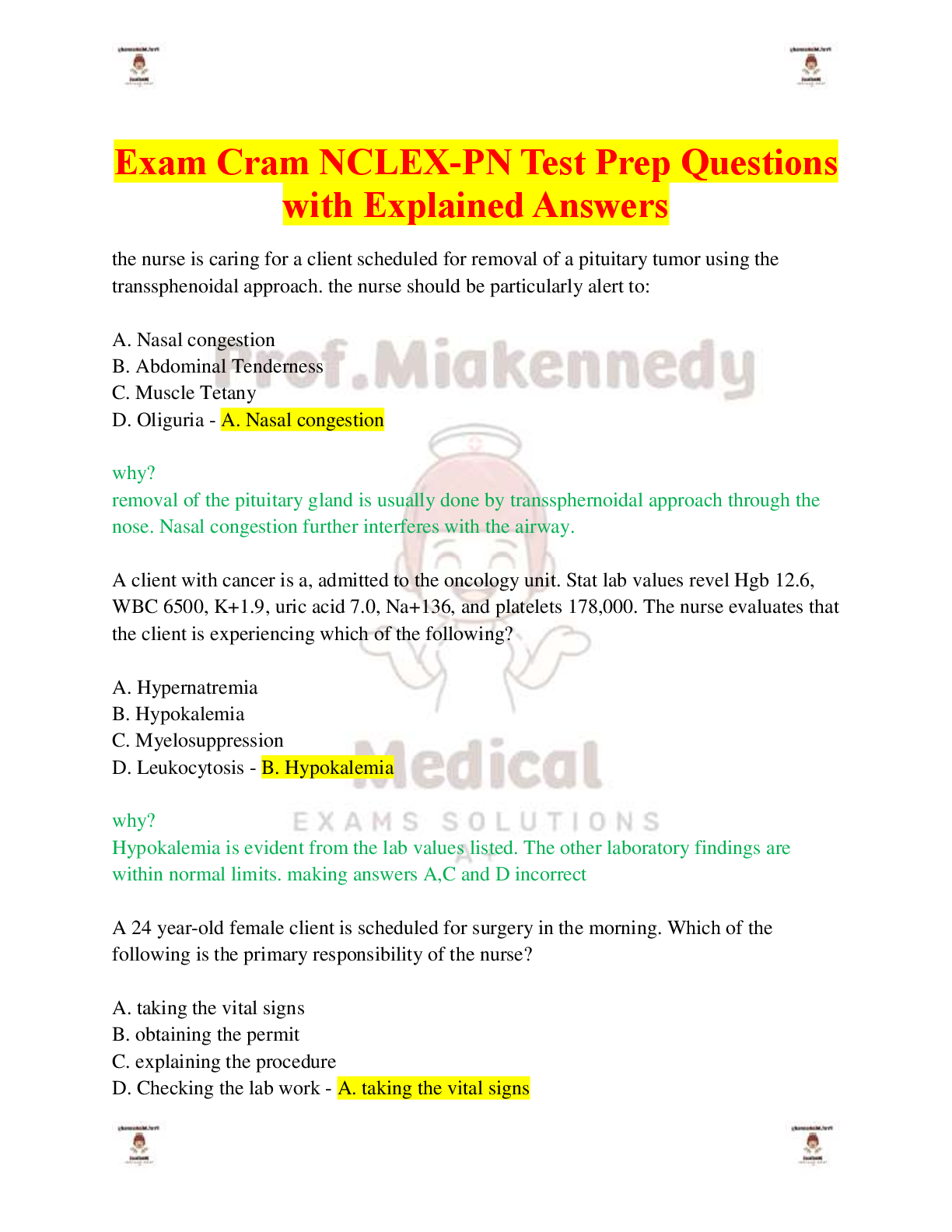
BUNDLE: LPN-NCLEX 2025-2026 EXAM SETS & TESTBANK, ALL RATED A+, Answered
BUNDLE: LPN-NCLEX 2025-2026 EXAM SETS & TESTBANK, ALL RATED A+, Answered
By PROF 1 week ago
$30.5
3
Reviews( 0 )
$18.50
Can't find what you want? Try our AI powered Search
Document information
Connected school, study & course
About the document
Uploaded On
Jul 16, 2025
Number of pages
272
Written in
Additional information
This document has been written for:
Uploaded
Jul 16, 2025
Downloads
0
Views
8

